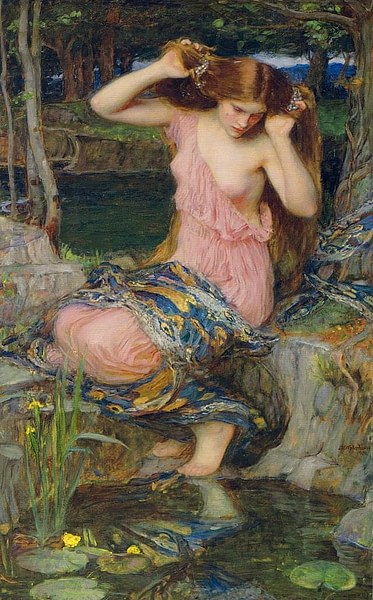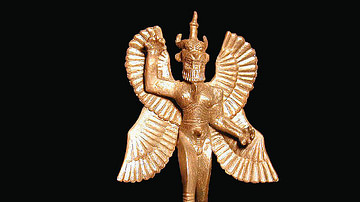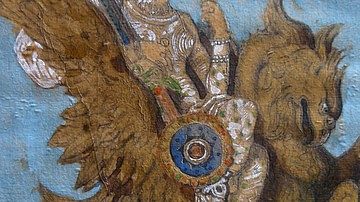
Lamia is a female or a hermaphroditic demon found in Greek mythology who devoured children and seduced men. She appears in literature as early as the 6th century BCE and is said to be fearsome to look upon with an ugly face, the upper body of a woman, and the lower body of a serpent.
Her name derives from the Greek laimos ("gullet") and lamyros ("gluttonous"), which perfectly describes her thirst for blood and hunger for human flesh. In later classical times, she became an early prototype of the vampire – seducing men with her beautiful looks and then drinking their blood. Over the years, she became a famous bogeyman story in Greece, told to children to make them behave.
Lamia & Zeus
In most sources, Lamia was the beautiful daughter of King Belus of Libya. However, the Greek lyric poet, Stesichorus (c. 630 to c. 555 BCE), mentions that she is the daughter of Poseidon, the god of the sea, and the mother of the sea monster, Scylla. Lamia's beauty unsurprisingly caught the attention of Zeus, who seduced her, and they had several children together. However, Hera was angered by her husband's infidelity and killed all of their children, except for one – Scylla. In other sources, Hera cruelly made Lamia kill her own children. Driven mad by her grief, Lamia set out to kill other children in a twisted form of revenge.
Her outer beauty soon reflected her hatred and anger, and she transformed from a beautiful woman into a demonic-looking creature. In a desperate attempt to appease her, Zeus gave her the gift of prophecy and the bizarre ability to pluck out her eyes and replace them, so she would not have to look at herself.
Appearance & Nature
Lamia was a half-human, half-serpent creature with a terrifying demonic face who lived in a cave and smelled horribly. According to the ancient Greek comedy playwright Aristophanes (c. 460 to c. 380 BCE), Lamia was hermaphroditic: "It had a voice like a roaring torrent, the stench of a seal, the unwashed balls of a Lamia and the arse of a camel." (Wasps, 1: 1035). The idea of Lamia being hermaphroditic was perhaps invented to make Lamia seem even more twisted and monstrous.
She would frequently creep into homes once darkness had fallen, steal infants from their cribs, and torment sleeping persons. Lamia's horrific act of killing babies and snatching infants from the womb ensured that other mothers would feel her pain by robbing them of their maternal duties and joys.
In later classical literature, Lamia joins forces with the Empusa, a group of demons who were either the daughters of the goddess Hecate or worked under her command. She began to be portrayed as a woman with the power to transform into a beautiful woman, lure young men, seduce and lie with them, and then drink their blood. Her penchant for drinking blood makes her one of the oldest figures from mythology who shares the characteristics of the modern vampire.
And that you may realize the truth of what I say, this fine bride is one of the vampires, that is to say of those beings whom the many regard as lamias and hobgoblins. These beings fall in love, and they are devoted to the delights of Aphrodite, but especially to the flesh of human beings, and they decoy with such delights those whom they mean to devour in their feasts. (Philostratus, Life of Apollonius, 4.21-25).
Depictions
A creature believed to be Lamia can be found on ancient Greek vases. On two of the vases - both Attic black vases (c. 500 BCE), she is depicted as a hairy, menacing figure with enormous breasts, large talons, and prominent fangs. Her portrayal on the second vase has caused some debate – a naked Lamia is bound to a palm tree (symbolising her ties to Libya) and is being tortured by five satyrs. Art historian John Boardman claims that a satyr is shown burning her pubic hair. In contrast, historian Monique Halm-Tisserant argues that the damaged vase shows that the figure has an erect phallus, giving credence that the creature on the vase is indeed Lamia, as Aristophanes' description of her as a hermaphrodite was widely known at the time.

One of Lamia's more modern and famous portrayals is found in the narrative poem Lamia (1819), written by the English poet John Keats (1795-1821). In Lamia, the Greek god Hermes sets out to find a nymph who is rumoured to be more beautiful than any other nymph. Failing in his mission to find this famed nymph, Hermes sits down to rest but soon hears a voice. Getting up to investigate, he comes across Lamia, who is trapped in the body of a serpent. Lamia promises to reveal the location of the elusive nymph to Hermes if he turns her back into a human woman, as a young Corinthian male called Lycius had caught her eye. Hermes agrees and transforms her into a beautiful woman.
Lycius passes by Lamia on his way to Corinth, and as soon as he sees her, he falls passionately in love. They lived in isolation in Corinth until Lycius suggested they get married and invite their loved ones to the celebration. Lamia is opposed but eventually agrees on one condition: that the philosopher Apollonius of Tyana is not invited. Not surprisingly, Apollonius of Tyana shows up uninvited. Staring pointedly at Lamia, Lycius notices her discomfort and tells Apollonius to stop staring at her. Apollonius replies:
"Fool!" said the sophist, in an under-tone
Gruff with contempt; which a death-nighing moan
From Lycius answer'd, as heart-struck and lost,
He sank supine beside the aching ghost.
"Fool! Fool!" repeated he, while his eyes still
Relented not, nor mov'd; "from every ill
Of life have I preserv'd thee to this day,
And shall I see thee made a serpent's prey?"
Then Lamia breath'd death breath; the sophist's eye,
Like a sharp spear, went through her utterly,
Keen, cruel, perceant, stinging: she, as well
As her weak hand could any meaning tell,
Motion'd him to be silent; vainly so,
He look'd and look'd again a level—No!
"A Serpent!" echoed he; no sooner said,
Than with a frightful scream she vanished:
And Lycius' arms were empty of delight. (John Keats, Lamia, Part 2)
As soon as Lamia vanishes from the wedding celebration, Lycius dies from a broken heart.
English painter John William Waterhouse (1849-1917) also found inspiration in the story of Lamia. In Lamia and the Soldier (1905), John William Waterhouse is inspired by John Keats' Lamia. It shows Lamia as a beautiful woman with a soldier (Lycius) looking at her in awe. However, look closely, and you will see a snakeskin hanging off her arm and a serpent's tail, symbolising her monstrous nature lying in wait. In Lamia (1909), Lamia sits staring at her beautiful reflection in a pool of water. The only clue to her true form is the dark blue embroidered cloth surrounding her, which is believed to symbolise snake skin. Other artists from the same period also used this method: painting Lamia as a young, enchanting woman, but always including a hint of her true nature, usually in the form of snakeskin being present somewhere in the painting.
Similarities with Other Demons
British poet and historian Robert Graves (1895-1985) referred to Lamia as being the demonised form of Neith (also called Anatha and Athene), the Libyan goddess of war and love whose worship the Achaeans forbade. There are also parallels between Lamia and the Sumerian Lamme, creatures who ate the flesh of children.
She has also been compared to the biblical Lilith, with the name Lilith-Lamia being coined to refer to both demons. They shared a similar appearance and were viewed as a threat to newborns and children. In addition, they both possess unclean sexual connotations and suck the blood from their lovers. Together, they are referred to as a "night hag", "night monster", and "night fairy".
Lamia Throughout History
In Greek society, Lamia was viewed as a cautionary tale of what women became when they lost their moral compass. Good Greek women were supposed to marry and mate with young men - not kill them, and their duty was to produce and care for children - not devour them. Philosophers used her as a negative example of desire and greed; what may appear to be attractive and seductive will later always end in ruin and corruption. The story of Lamia was also used to scare children into behaving well. She was the bogeyman of ancient Greece.
Both Artistotle (384-322 BCE) and the natural philosopher Albert the Great (d. 1280 CE) try to make sense of Lamia by comparing her to an animal, giving sense to the natural world. In his History of Animals, Aristotle refers to a large fish known as the "lamia-shark", an idea which has endured, as later Greeks have a Lamia of the sea – a dangerous mermaid-like creature.
In his De animalibus (On Animals), Albert the Great refers to the Lamia as a large animal-woman hybrid who nurses their young and is devoted to them. Lamia being dedicated to her young makes more sense than a woman who cruelly kills and eats children, as it goes against everything a woman is supposed to represent.
Lamia's cruel and tortured nature has remained recognisable throughout history. She has been used to scare children into behaving, and as a moral lesson, inspired poets and artists and helped to reestablish the importance of the natural sciences.









